Analysis of Promoting Positive Behavior in Health and Social Care
VerifiedAdded on 2020/07/22
|7
|1593
|266
Report
AI Summary
This report delves into the crucial topic of promoting positive behavior within health, social care, and early years sectors. It begins by outlining relevant legislation and guidelines, emphasizing the significance of maintaining positive behavior in these settings. The report explores various interventions, including behavior plans and functional behavior plans, and differentiates between proactive and reactive strategies. It highlights the importance of a person-centered approach when establishing proactive strategies, as well as best practices for promoting positive behavior. Furthermore, the report addresses challenging behaviors, providing steps to maintain dignity and respect for individuals, and concludes with a discussion on role-playing scenarios to support well-being and effective intervention techniques. The report also provides an overview of how to implement least restrictive intervention and the importance of safeguards if restrictive physical interventions are used.
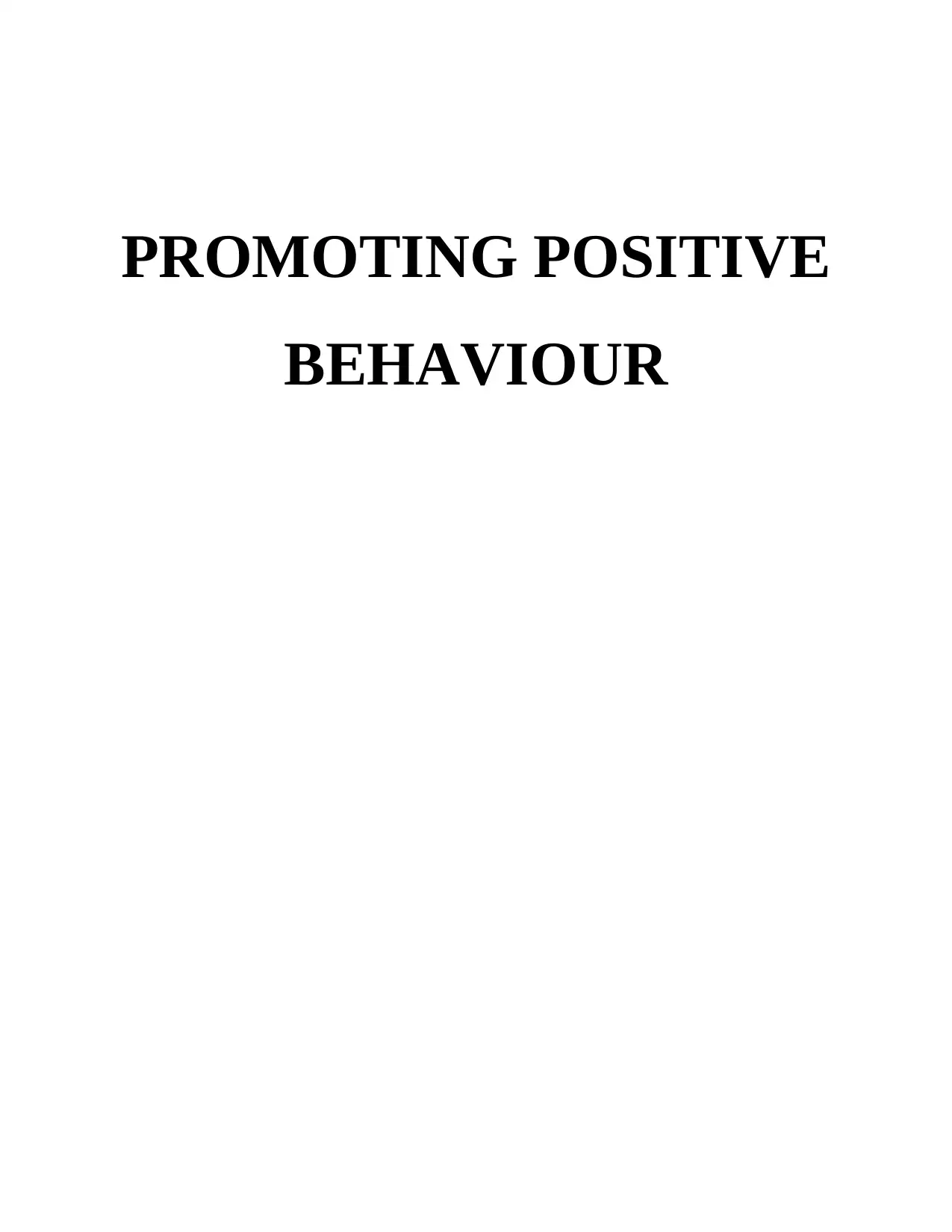
PROMOTING POSITIVE
BEHAVIOUR
BEHAVIOUR
Paraphrase This Document
Need a fresh take? Get an instant paraphrase of this document with our AI Paraphraser
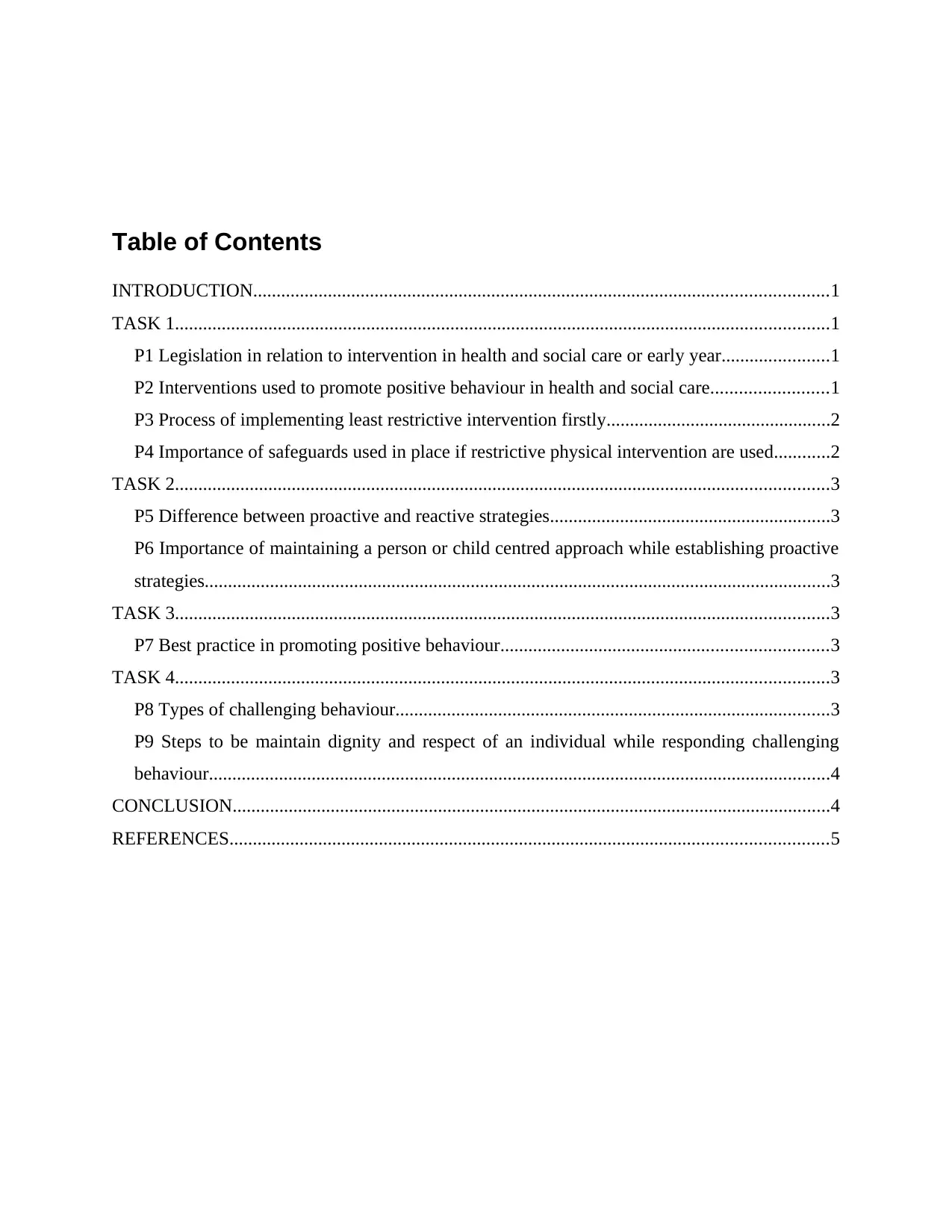
Table of Contents
INTRODUCTION...........................................................................................................................1
TASK 1............................................................................................................................................1
P1 Legislation in relation to intervention in health and social care or early year.......................1
P2 Interventions used to promote positive behaviour in health and social care.........................1
P3 Process of implementing least restrictive intervention firstly................................................2
P4 Importance of safeguards used in place if restrictive physical intervention are used............2
TASK 2............................................................................................................................................3
P5 Difference between proactive and reactive strategies............................................................3
P6 Importance of maintaining a person or child centred approach while establishing proactive
strategies......................................................................................................................................3
TASK 3............................................................................................................................................3
P7 Best practice in promoting positive behaviour......................................................................3
TASK 4............................................................................................................................................3
P8 Types of challenging behaviour.............................................................................................3
P9 Steps to be maintain dignity and respect of an individual while responding challenging
behaviour.....................................................................................................................................4
CONCLUSION................................................................................................................................4
REFERENCES................................................................................................................................5
INTRODUCTION...........................................................................................................................1
TASK 1............................................................................................................................................1
P1 Legislation in relation to intervention in health and social care or early year.......................1
P2 Interventions used to promote positive behaviour in health and social care.........................1
P3 Process of implementing least restrictive intervention firstly................................................2
P4 Importance of safeguards used in place if restrictive physical intervention are used............2
TASK 2............................................................................................................................................3
P5 Difference between proactive and reactive strategies............................................................3
P6 Importance of maintaining a person or child centred approach while establishing proactive
strategies......................................................................................................................................3
TASK 3............................................................................................................................................3
P7 Best practice in promoting positive behaviour......................................................................3
TASK 4............................................................................................................................................3
P8 Types of challenging behaviour.............................................................................................3
P9 Steps to be maintain dignity and respect of an individual while responding challenging
behaviour.....................................................................................................................................4
CONCLUSION................................................................................................................................4
REFERENCES................................................................................................................................5
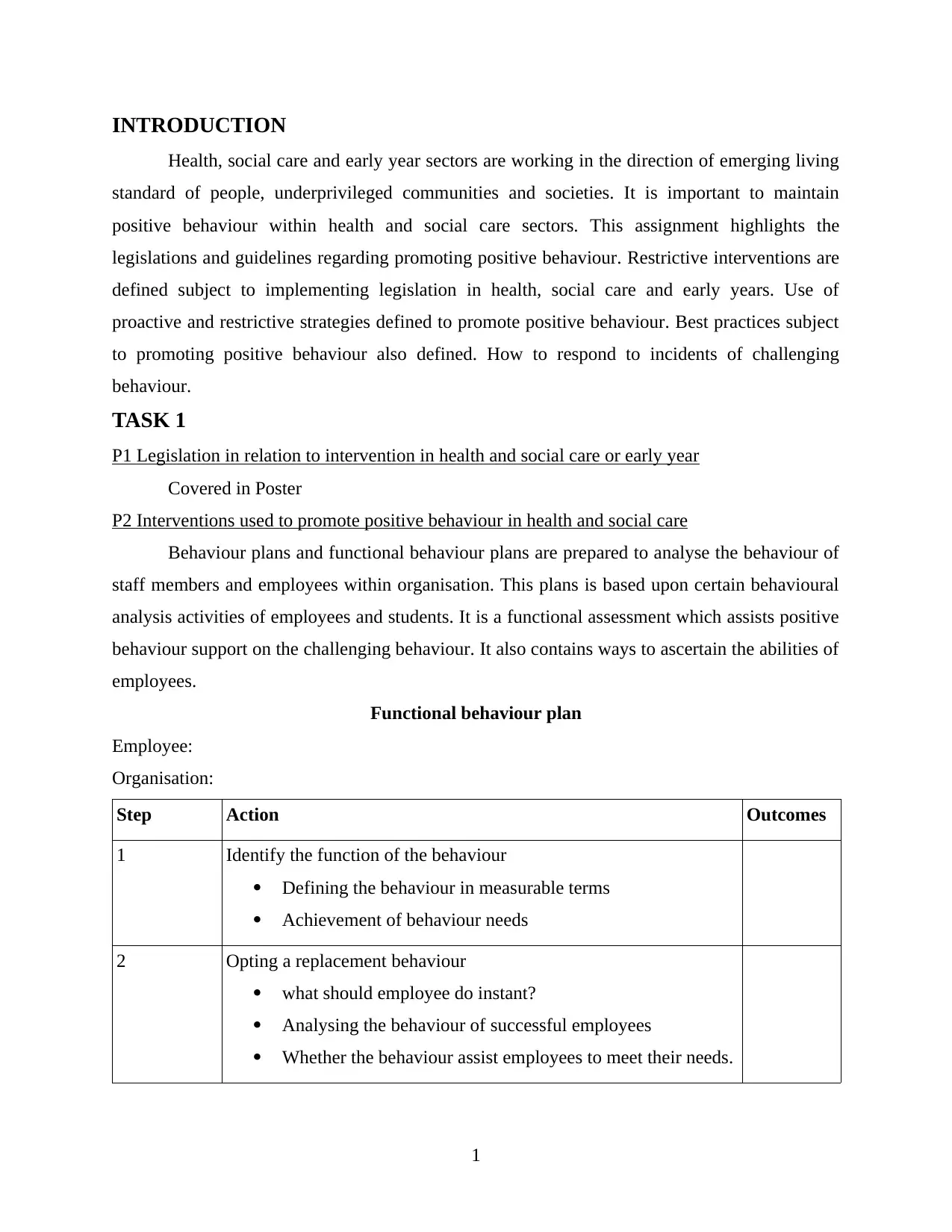
INTRODUCTION
Health, social care and early year sectors are working in the direction of emerging living
standard of people, underprivileged communities and societies. It is important to maintain
positive behaviour within health and social care sectors. This assignment highlights the
legislations and guidelines regarding promoting positive behaviour. Restrictive interventions are
defined subject to implementing legislation in health, social care and early years. Use of
proactive and restrictive strategies defined to promote positive behaviour. Best practices subject
to promoting positive behaviour also defined. How to respond to incidents of challenging
behaviour.
TASK 1
P1 Legislation in relation to intervention in health and social care or early year
Covered in Poster
P2 Interventions used to promote positive behaviour in health and social care
Behaviour plans and functional behaviour plans are prepared to analyse the behaviour of
staff members and employees within organisation. This plans is based upon certain behavioural
analysis activities of employees and students. It is a functional assessment which assists positive
behaviour support on the challenging behaviour. It also contains ways to ascertain the abilities of
employees.
Functional behaviour plan
Employee:
Organisation:
Step Action Outcomes
1 Identify the function of the behaviour
Defining the behaviour in measurable terms
Achievement of behaviour needs
2 Opting a replacement behaviour
what should employee do instant?
Analysing the behaviour of successful employees
Whether the behaviour assist employees to meet their needs.
1
Health, social care and early year sectors are working in the direction of emerging living
standard of people, underprivileged communities and societies. It is important to maintain
positive behaviour within health and social care sectors. This assignment highlights the
legislations and guidelines regarding promoting positive behaviour. Restrictive interventions are
defined subject to implementing legislation in health, social care and early years. Use of
proactive and restrictive strategies defined to promote positive behaviour. Best practices subject
to promoting positive behaviour also defined. How to respond to incidents of challenging
behaviour.
TASK 1
P1 Legislation in relation to intervention in health and social care or early year
Covered in Poster
P2 Interventions used to promote positive behaviour in health and social care
Behaviour plans and functional behaviour plans are prepared to analyse the behaviour of
staff members and employees within organisation. This plans is based upon certain behavioural
analysis activities of employees and students. It is a functional assessment which assists positive
behaviour support on the challenging behaviour. It also contains ways to ascertain the abilities of
employees.
Functional behaviour plan
Employee:
Organisation:
Step Action Outcomes
1 Identify the function of the behaviour
Defining the behaviour in measurable terms
Achievement of behaviour needs
2 Opting a replacement behaviour
what should employee do instant?
Analysing the behaviour of successful employees
Whether the behaviour assist employees to meet their needs.
1
⊘ This is a preview!⊘
Do you want full access?
Subscribe today to unlock all pages.

Trusted by 1+ million students worldwide
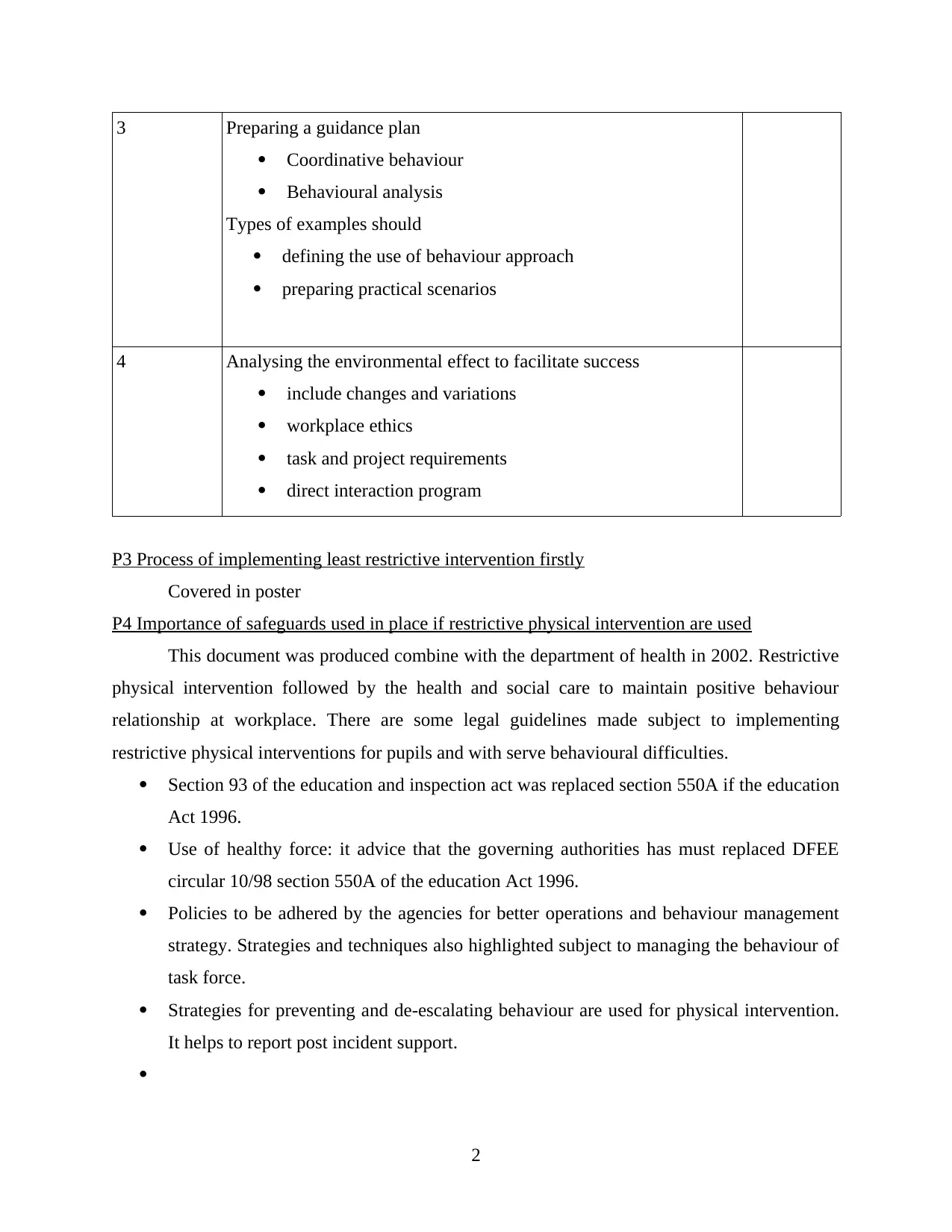
3 Preparing a guidance plan
Coordinative behaviour
Behavioural analysis
Types of examples should
defining the use of behaviour approach
preparing practical scenarios
4 Analysing the environmental effect to facilitate success
include changes and variations
workplace ethics
task and project requirements
direct interaction program
P3 Process of implementing least restrictive intervention firstly
Covered in poster
P4 Importance of safeguards used in place if restrictive physical intervention are used
This document was produced combine with the department of health in 2002. Restrictive
physical intervention followed by the health and social care to maintain positive behaviour
relationship at workplace. There are some legal guidelines made subject to implementing
restrictive physical interventions for pupils and with serve behavioural difficulties.
Section 93 of the education and inspection act was replaced section 550A if the education
Act 1996.
Use of healthy force: it advice that the governing authorities has must replaced DFEE
circular 10/98 section 550A of the education Act 1996.
Policies to be adhered by the agencies for better operations and behaviour management
strategy. Strategies and techniques also highlighted subject to managing the behaviour of
task force.
Strategies for preventing and de-escalating behaviour are used for physical intervention.
It helps to report post incident support.
2
Coordinative behaviour
Behavioural analysis
Types of examples should
defining the use of behaviour approach
preparing practical scenarios
4 Analysing the environmental effect to facilitate success
include changes and variations
workplace ethics
task and project requirements
direct interaction program
P3 Process of implementing least restrictive intervention firstly
Covered in poster
P4 Importance of safeguards used in place if restrictive physical intervention are used
This document was produced combine with the department of health in 2002. Restrictive
physical intervention followed by the health and social care to maintain positive behaviour
relationship at workplace. There are some legal guidelines made subject to implementing
restrictive physical interventions for pupils and with serve behavioural difficulties.
Section 93 of the education and inspection act was replaced section 550A if the education
Act 1996.
Use of healthy force: it advice that the governing authorities has must replaced DFEE
circular 10/98 section 550A of the education Act 1996.
Policies to be adhered by the agencies for better operations and behaviour management
strategy. Strategies and techniques also highlighted subject to managing the behaviour of
task force.
Strategies for preventing and de-escalating behaviour are used for physical intervention.
It helps to report post incident support.
2
Paraphrase This Document
Need a fresh take? Get an instant paraphrase of this document with our AI Paraphraser
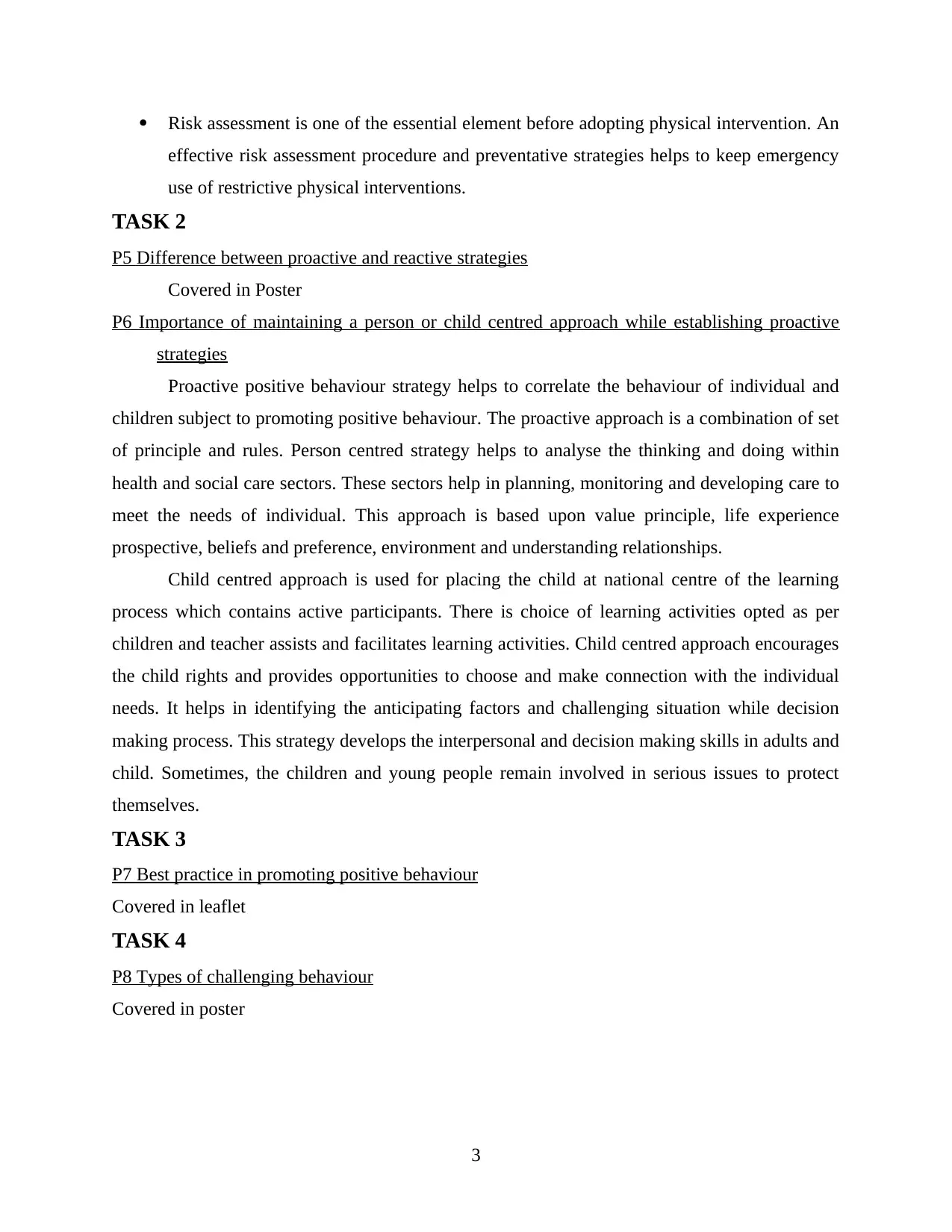
Risk assessment is one of the essential element before adopting physical intervention. An
effective risk assessment procedure and preventative strategies helps to keep emergency
use of restrictive physical interventions.
TASK 2
P5 Difference between proactive and reactive strategies
Covered in Poster
P6 Importance of maintaining a person or child centred approach while establishing proactive
strategies
Proactive positive behaviour strategy helps to correlate the behaviour of individual and
children subject to promoting positive behaviour. The proactive approach is a combination of set
of principle and rules. Person centred strategy helps to analyse the thinking and doing within
health and social care sectors. These sectors help in planning, monitoring and developing care to
meet the needs of individual. This approach is based upon value principle, life experience
prospective, beliefs and preference, environment and understanding relationships.
Child centred approach is used for placing the child at national centre of the learning
process which contains active participants. There is choice of learning activities opted as per
children and teacher assists and facilitates learning activities. Child centred approach encourages
the child rights and provides opportunities to choose and make connection with the individual
needs. It helps in identifying the anticipating factors and challenging situation while decision
making process. This strategy develops the interpersonal and decision making skills in adults and
child. Sometimes, the children and young people remain involved in serious issues to protect
themselves.
TASK 3
P7 Best practice in promoting positive behaviour
Covered in leaflet
TASK 4
P8 Types of challenging behaviour
Covered in poster
3
effective risk assessment procedure and preventative strategies helps to keep emergency
use of restrictive physical interventions.
TASK 2
P5 Difference between proactive and reactive strategies
Covered in Poster
P6 Importance of maintaining a person or child centred approach while establishing proactive
strategies
Proactive positive behaviour strategy helps to correlate the behaviour of individual and
children subject to promoting positive behaviour. The proactive approach is a combination of set
of principle and rules. Person centred strategy helps to analyse the thinking and doing within
health and social care sectors. These sectors help in planning, monitoring and developing care to
meet the needs of individual. This approach is based upon value principle, life experience
prospective, beliefs and preference, environment and understanding relationships.
Child centred approach is used for placing the child at national centre of the learning
process which contains active participants. There is choice of learning activities opted as per
children and teacher assists and facilitates learning activities. Child centred approach encourages
the child rights and provides opportunities to choose and make connection with the individual
needs. It helps in identifying the anticipating factors and challenging situation while decision
making process. This strategy develops the interpersonal and decision making skills in adults and
child. Sometimes, the children and young people remain involved in serious issues to protect
themselves.
TASK 3
P7 Best practice in promoting positive behaviour
Covered in leaflet
TASK 4
P8 Types of challenging behaviour
Covered in poster
3
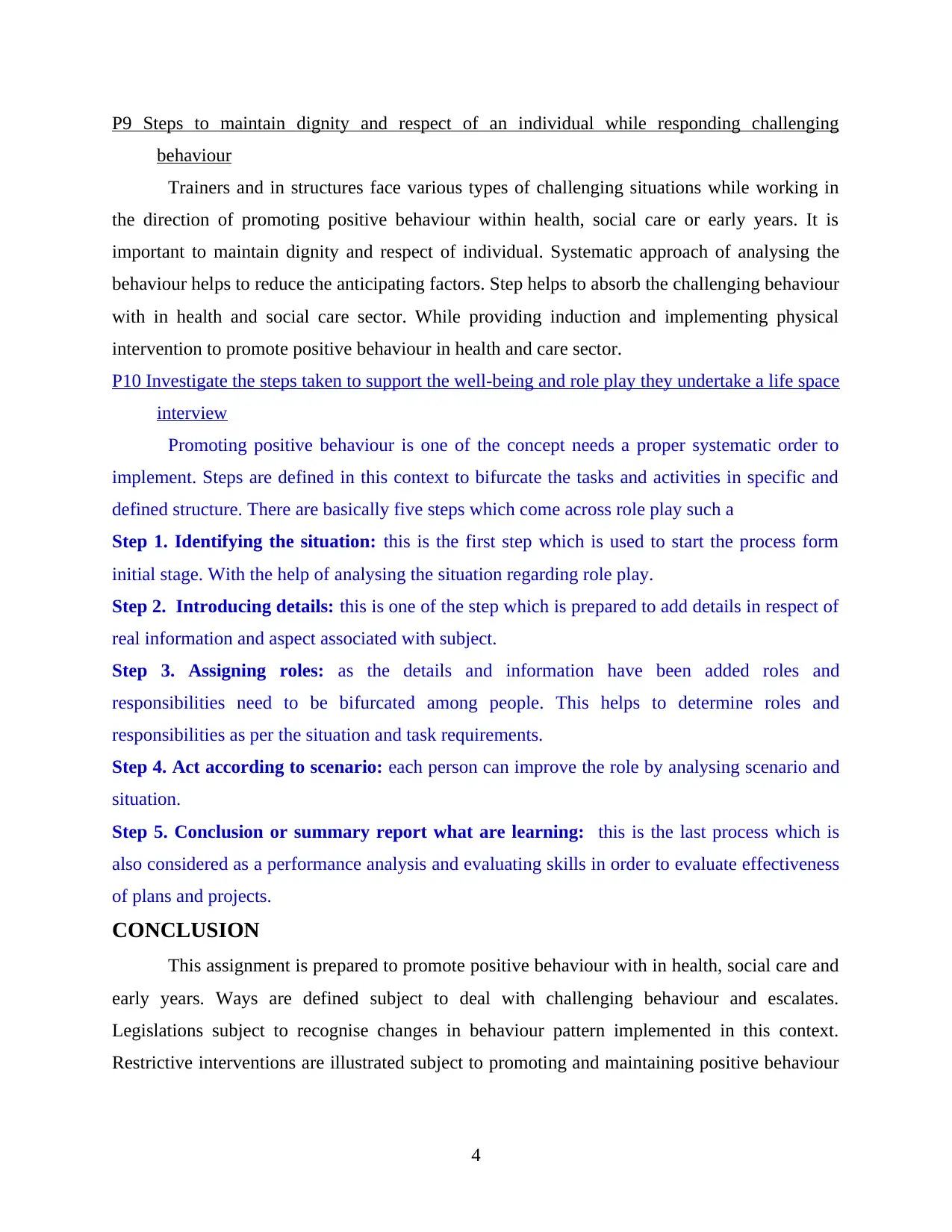
P9 Steps to maintain dignity and respect of an individual while responding challenging
behaviour
Trainers and in structures face various types of challenging situations while working in
the direction of promoting positive behaviour within health, social care or early years. It is
important to maintain dignity and respect of individual. Systematic approach of analysing the
behaviour helps to reduce the anticipating factors. Step helps to absorb the challenging behaviour
with in health and social care sector. While providing induction and implementing physical
intervention to promote positive behaviour in health and care sector.
P10 Investigate the steps taken to support the well-being and role play they undertake a life space
interview
Promoting positive behaviour is one of the concept needs a proper systematic order to
implement. Steps are defined in this context to bifurcate the tasks and activities in specific and
defined structure. There are basically five steps which come across role play such a
Step 1. Identifying the situation: this is the first step which is used to start the process form
initial stage. With the help of analysing the situation regarding role play.
Step 2. Introducing details: this is one of the step which is prepared to add details in respect of
real information and aspect associated with subject.
Step 3. Assigning roles: as the details and information have been added roles and
responsibilities need to be bifurcated among people. This helps to determine roles and
responsibilities as per the situation and task requirements.
Step 4. Act according to scenario: each person can improve the role by analysing scenario and
situation.
Step 5. Conclusion or summary report what are learning: this is the last process which is
also considered as a performance analysis and evaluating skills in order to evaluate effectiveness
of plans and projects.
CONCLUSION
This assignment is prepared to promote positive behaviour with in health, social care and
early years. Ways are defined subject to deal with challenging behaviour and escalates.
Legislations subject to recognise changes in behaviour pattern implemented in this context.
Restrictive interventions are illustrated subject to promoting and maintaining positive behaviour
4
behaviour
Trainers and in structures face various types of challenging situations while working in
the direction of promoting positive behaviour within health, social care or early years. It is
important to maintain dignity and respect of individual. Systematic approach of analysing the
behaviour helps to reduce the anticipating factors. Step helps to absorb the challenging behaviour
with in health and social care sector. While providing induction and implementing physical
intervention to promote positive behaviour in health and care sector.
P10 Investigate the steps taken to support the well-being and role play they undertake a life space
interview
Promoting positive behaviour is one of the concept needs a proper systematic order to
implement. Steps are defined in this context to bifurcate the tasks and activities in specific and
defined structure. There are basically five steps which come across role play such a
Step 1. Identifying the situation: this is the first step which is used to start the process form
initial stage. With the help of analysing the situation regarding role play.
Step 2. Introducing details: this is one of the step which is prepared to add details in respect of
real information and aspect associated with subject.
Step 3. Assigning roles: as the details and information have been added roles and
responsibilities need to be bifurcated among people. This helps to determine roles and
responsibilities as per the situation and task requirements.
Step 4. Act according to scenario: each person can improve the role by analysing scenario and
situation.
Step 5. Conclusion or summary report what are learning: this is the last process which is
also considered as a performance analysis and evaluating skills in order to evaluate effectiveness
of plans and projects.
CONCLUSION
This assignment is prepared to promote positive behaviour with in health, social care and
early years. Ways are defined subject to deal with challenging behaviour and escalates.
Legislations subject to recognise changes in behaviour pattern implemented in this context.
Restrictive interventions are illustrated subject to promoting and maintaining positive behaviour
4
⊘ This is a preview!⊘
Do you want full access?
Subscribe today to unlock all pages.

Trusted by 1+ million students worldwide
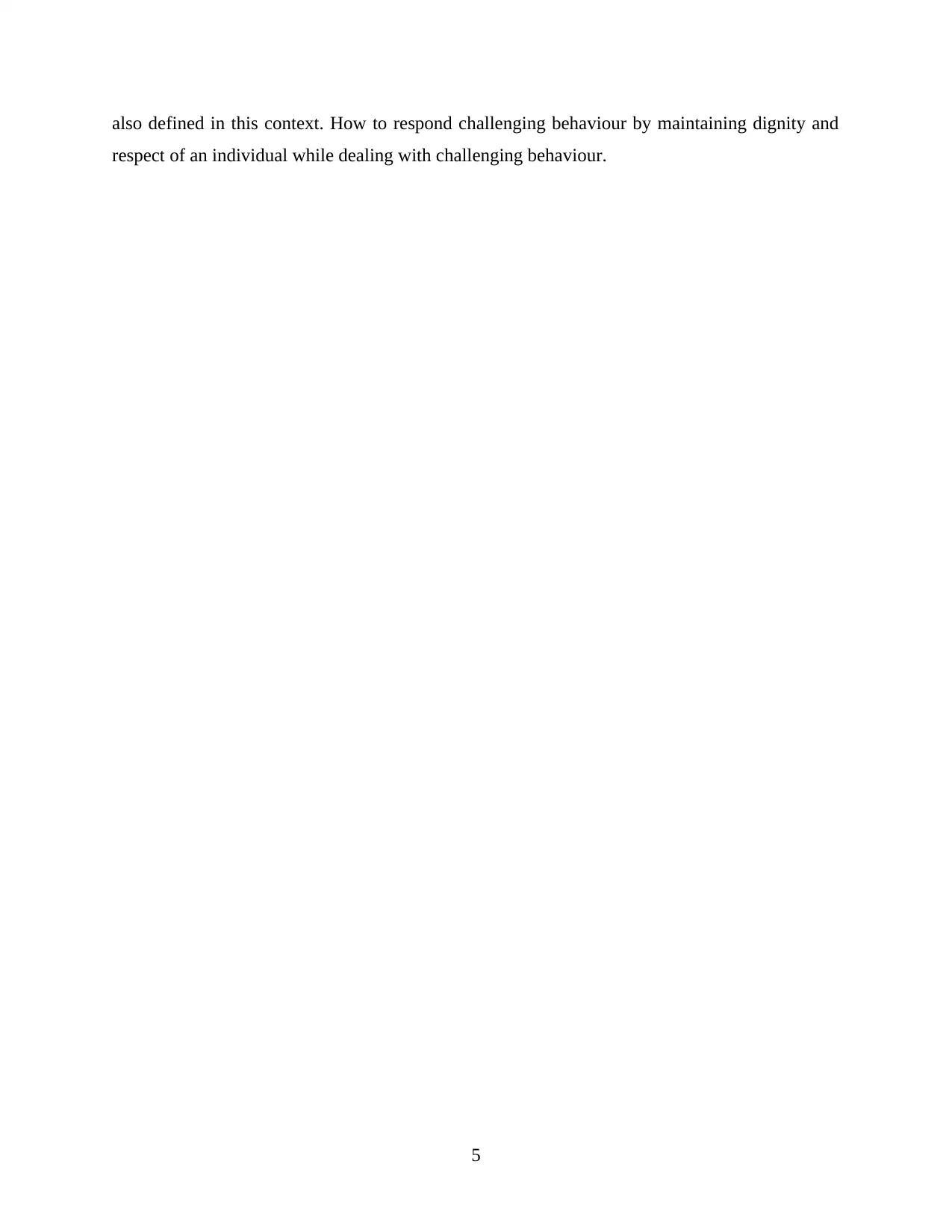
also defined in this context. How to respond challenging behaviour by maintaining dignity and
respect of an individual while dealing with challenging behaviour.
5
respect of an individual while dealing with challenging behaviour.
5
1 out of 7
Related Documents
Your All-in-One AI-Powered Toolkit for Academic Success.
+13062052269
info@desklib.com
Available 24*7 on WhatsApp / Email
![[object Object]](/_next/static/media/star-bottom.7253800d.svg)
Unlock your academic potential
Copyright © 2020–2025 A2Z Services. All Rights Reserved. Developed and managed by ZUCOL.





